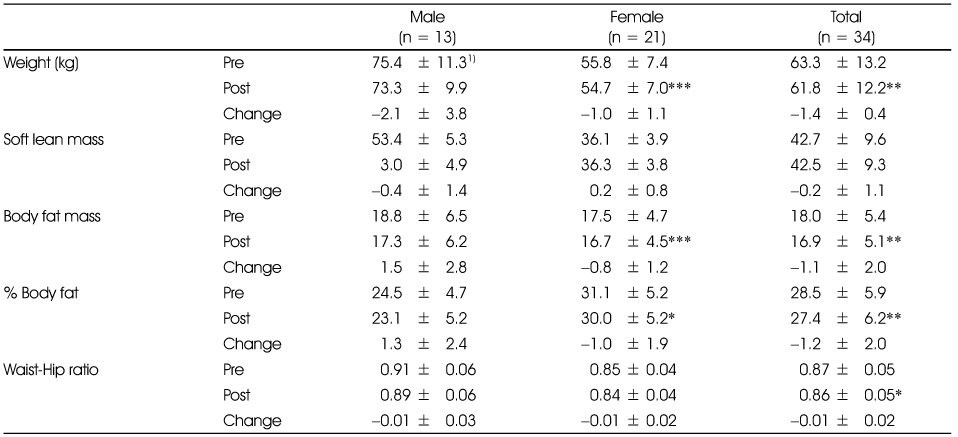References
1. Brownell KD, Bachorik PS, Ayerle RS. Changes in plasma lipid and lipoprotein levels in men and women after a program of moderate exercise. Circulation 1982;65:477–484.
2. Dattilo MA, Kris-Etherton PM. Effects of weight reduction on blood lipids and lipoprotein : A meta analysis. Am J Clin Nutr 1992;56:320–328.
3. Friedewald WT, Levy RI, Fredrickson DS. Estimation of the concentration of low-density lipoprotein cholesterol in plasma without use of the preparative ultracentrifuge. Clin Chem 1972;18(6):499–502.
4. George A, Bray MD. Contemporary diagnosis and management of obesity Handbooks in Health Care. Co; 1998.
5. Glanz K, Lewis FM, Rimer BK. The scope of health education. In : Glanz K, Lewis FM, Rimer BK, eds. Health behavior and health education. Theory, research, and practice 2nd edth ed. Jossesy Bass Pub, SF; 1997. p. 3–18.
6. Gray DS. Diagnosis and prevalence of obesity. Med Clin North Am 1989;73(1):1–13.
7. Hebert JR, Ebbeling CB, Ockene IS, Ma Y, Rider L, Merriam PA, Ockene JK, Saperia GM. A Dietitian-delivered group nutrition program leads to reductions in dietary fat, serum cholesterol, and body weight: The Worcester area trial for counseling in hyperlipidemia. J Am Diet Assoc 1999;99(5):544–552.
8. Hines L. Can low-fat/cholesterol nutrition counseling improve food intake habits and hyperlipidemia of renal transplant patients? J Ren Nutr 2000;10(1):30–35.
9. Kim JD. The changes in body composition, blood pressure, blood lipid profile and glucose according to participation pattern of exercise program on middle aged men. J Sport Leis Stud 2013;50:631–643.
10. Kim JS, Han JS. Effects of web-based nutrition counseling on dietary behavior and food intake in hyperlipidemic patients. J Korean Diet Assoc 2005;11(4):418–429.
11. Kim SJ, Jo YW, Yim JG, Kim YS. Effects of apo E polymorphisms and dietary counseling on the levels of plasmalipids in hyperlipidemic patients. Korean J Nutr 1998;31(9):1411–1421.
12. Kim TY, Suh MO. The effect of nutrition education on weight control in male workers by the community health center. J Korean Diet Assoc 2008;14(4):351–360.
13. Kim WS. The effect of obesity, blood pressure and lifestyle on lipid indices and blood pressure in men of age 40s. J Korean Soc Physiol Med 2013;8(2):239–243.
14. Korean National Statistical Office. The statistics of mortality and the cause 2012. cited 2013 October 12. Available from
http://www.kostat.go.kr.
15. Korean Society of Lipidology and Atherosclerosis. Therapeutic guidline for dyslipidemia 2009.
16. Lauver D. A theory of care seeking behavior. Image J Nurs Sch 1992;24(4):281–287.
17. Lee JH, Kim SA. The development & pactice of nutrition counselling materials at health diagnosis center In : Proceedings of 1999 Fall Symposium of the Korean Society of Community Nutrition; 1999. p. 94.
18. Lee JS, Park JS, Lee KH, Ko HS, Kim EK. Effect of body composition, serum lipid level and resting metabolic rate by nutritional education and exercise program in middle aged women. J Korean Diet Assoc 2008;14(1):64–76.
19. Lee SL. Effects of nutrition counseling on diabetes management in Type 2 diabetes mellitus patients. J Korean Diet Assoc 2009;15(2):188–195.
20. Lippincott Williams & Wilkins. ACSM's health-related physical fitness assessment manual 2004.
21. McNamara DJ. Dietary cholesterol and the optimal diet forreducing risk of atherosclerosis. Can J Cardiol 1995;11Suppl G. :123G–126G.
22. Ministry of Health & Welfare. Dietary guideline for adults 2009.
23. Ministry of Health & Welfare, Korea Centers for Disease Control and Prevention. Korea Health Statistics 2011 - Korea National Health and Nutrition Examination Survey 2012. cited 2013 April 3. Available from
http://knhanes.cdc.go.kr.
24. Ministry of Health & Welfare, Korea Health Promotion Foundation. Couseling manual for health examination 2012.
25. Moon EH, Kim KW. Evaluation of nutrition education for hypertension patients aged 50 years and over. Korean J Community Nutr 2011;16(1):62–74.
26. Moon SS, Lee SB. A study of health behavior through comparative analysis of self-perceived health status and healthexamination results. J Korean Soc Health Educ Promot 2001;18(3):11–36.
27. O'Donnell M. An emerging strategy for health enhancement and business cost saving in Korea (Unpublished) Health Promotion; 1999.
28. Oh SW, Shin SA, Yun YH, Yoo T, Huh BY. Cut-off point of BMI and obesity-related comorbidities and mortality in middle-aged Koreans. Obes Res 2004;12:2031–2040.
29. Ornish D, Brown SE, Scherwitz LW, Billings JH, Amstrong WT. Can lifestyle changes reverse coronary heart disease? Lancet 1990;336:129–133.
30. Park HD, Kim EJ, Hwang MO, Paek YM, Choi TI, Park YK. Effects of workplace nutrition education program tailored for the individual chronic disease risks. Korean J Nutr 2010;43(3):246–259.
31. Park SY. Retrospective evaluations of comparative atorvastatin versus rosuvastatin use in Korean patient with dyslipidemia 2007. Chungbuk National University: MS thesis.
32. Park YB. Cholesterol metabolism and regulation of related genes. Food Ind Nutr 2000;50(2):1–9.
33. Rhodes KS, Bookstein LC, Aaronson LS, Mercer NM, Orringer CE. Intensive nutrition counseling enhances outcomes of national cholesterol education program dietary therapy. J Am Diet Assoc 1996;96(10):1003–1010.
34. Shin MJ, Lim HS, Jung NS, Jo SY, Kim SS. Effect of dietary therapy on blood lipid in outpatients with hypercholesterolemia. J Korean Diet Assoc 2001;7(4):313–319.
35. Son JM, Kim SK, Park HK, Shin CS, Kim SY, Lee HK. The study on the effect of nutritional counseling in diabetes mellituspatients with microalbuminuria. J Korean Diet Assoc 2001;7(2):138–143.
36. Walden CE, Retzlaff BM, Buck BL. Lipoprotein lipid response to the national cholesterol education program step diet by hypercholesterolemia and combined hyperlipidemic women and men. Arterioscler Thromb Vasc Biol 1997;17(2):375–382.
37. Wang SG, Park SM. The effects of nutrition counseling on food intakes and Bbood lipids in cardiac patients. Korean J Community Nutr 2002;7(1):92–101.
38. Yang IS, Lee JM, Chae IS. Nutrition knowledge and attitude analysis of elderly people for the development of nutrition education program. J Korean Diet Assoc 1998;4(1):76–87.
39. Yoon CK. The study on the relationship between health concern, health behavior, and subjective health cognition. J Korean Soc Health Inf Health Stat 2004;29(1):37–46.





